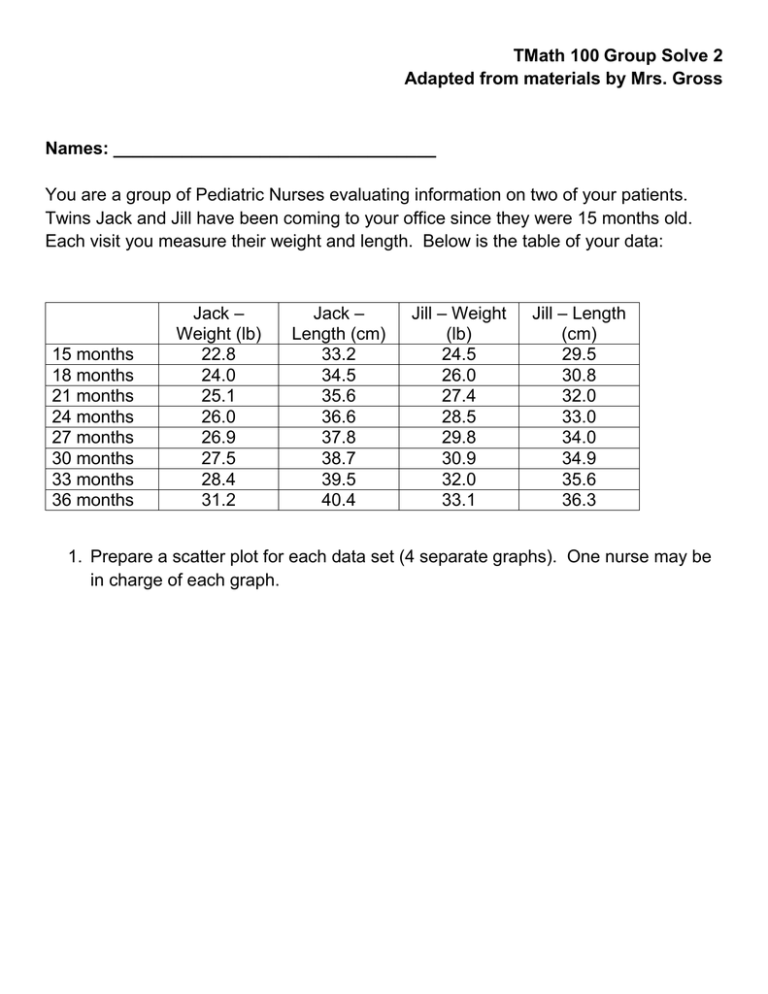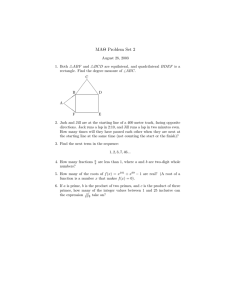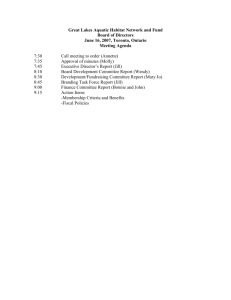GS 2 Solutions .doc
advertisement

TMath 100 Group Solve 2 Adapted from materials by Mrs. Gross Names: _________________________________ You are a group of Pediatric Nurses evaluating information on two of your patients. Twins Jack and Jill have been coming to your office since they were 15 months old. Each visit you measure their weight and length. Below is the table of your data: 15 months 18 months 21 months 24 months 27 months 30 months 33 months 36 months Jack – Weight (lb) 22.8 24.0 25.1 26.0 26.9 27.5 28.4 31.2 Jack – Length (cm) 33.2 34.5 35.6 36.6 37.8 38.7 39.5 40.4 Jill – Weight (lb) 24.5 26.0 27.4 28.5 29.8 30.9 32.0 33.1 Jill – Length (cm) 29.5 30.8 32.0 33.0 34.0 34.9 35.6 36.3 1. Prepare a scatter plot for each data set (4 separate graphs). One nurse may be in charge of each graph. 2. Determine the equation of a “Good Fit” line for each data set. Jack’s Weight: w = 0.353m + 17.5 Jack’s Length: L = 0.351m + 28.1 Jill’s Weight: w = 0.413m + 18.5 Jill’s Length: L = 0.339m + 24.7 You may have different variables and slightly different numbers, but your numbers must all have 3 sig figs. 3. What is your estimated birth weight and birth length for each child? Are these extrapolated or interpolated values? According to these models, Jack weighed 17.5 lbs and was 28.1 cm long at birth, and Jill weighed 18.5 lbs and was 24.7 cm long at birth. These are extrapolated values. That is why the birth weights are so unreasonable. Birth (m = 0) is a long way away from the data which starts at m = 15. 4. Write the equation of each line as a function, where W(t) is the weight at age t, and L(t) is the length at age t. Jack’s Weight: W(t) = 0.353t + 17.5 Jack’s Length: L(t) = 0.351t + 28.1 Jill’s Weight: W(t) = 0.413t + 18.5 Jill’s Length: L(t) = 0.339t + 24.7 Note: we only use parentheses in the name of the function (the left hand side), not in the rule (the right hand side). 5. Using the above functions, find W(28) and L(28). Explain your answer; what do W(28) and L(28) mean? Are they extrapolated or interpolated values? For Jack: W(28) = 0.353(28) + 17.5 = 27.4 and L(28) = 0.351(28) + 28.1 = 37.9 When Jack was 28 months old, he weighed 27.4 pounds and was 37.9 cm long. For Jill: W(28) = 0.413(28) + 18.5 = 30.1 and L(28) = 30.1 and L(28) = 0.339(28) + 24.7 = 34.2 When Jill was 28 months old, she weighed 30.1 pounds and was 34.2 cm long. These values are interpolated. They are within the range of the data, so they are very close to the actual values given in the chart for age 27 months. 6. Jack has been diagnosed with scarlet fever. He needs to receive an injection of 9 x 105 units of Penicillin G Benzathine. It is available in a solution with 1.2 x 106 units in two mL. How many mL of the solution should Jack get in the IM injection? Use the dosage proportion from the Supplement to show your work. Use the dosage proportion to find the amount given. Known Dosage Available Dosage Ordered Dosage Form Amount to be Given Cross multiply to get: Divide both sides by to get: Jack’s injection should contain 1.5 mL. I will also accept 2 mL. 7. Jill’s case is not as serious as Jack’s, so she is being given ampicillin for 10 days. The dosage for ampicillin is 150mg/kg/day administered every 6 hours. It is available as a solution with 125 mg in 5 mL. How many mL should Jill be given each dose? How many mL should Jill be given for the ten days? Use unit analysis to make any conversions needed and the dosage proportion from the Supplement to show your work. 1. First convert 33.1 lb, Jill’s weight from the table, to kg. With three sig figs, Jill weighs 15.0 kg. 2. Use 150 mg/kg/day to find the dosage needed: Cross multiply to get: Jill should get 2250 mg per day. 3. To find the number of mL, we use the dosage proportion: Known Dosage Available Dosage Ordered Dosage Form Amount to be Given Cross multiply to get: Divide both sides by to get: Jill should take 90 mL a day and 90 4 = 22.5 mL each dose. She will need 90 mL times 10 or 900 mL for the 10-day supply.


